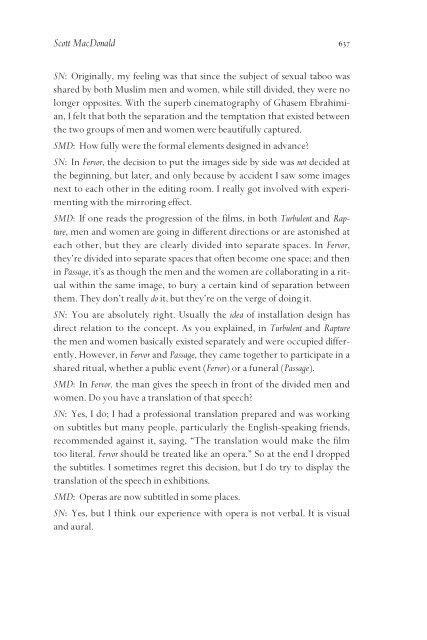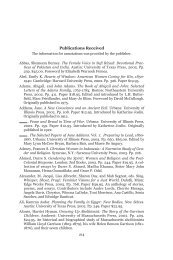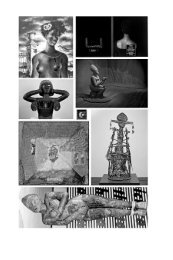An Interview with Shirin Neshat - Feminist Studies
An Interview with Shirin Neshat - Feminist Studies
An Interview with Shirin Neshat - Feminist Studies
You also want an ePaper? Increase the reach of your titles
YUMPU automatically turns print PDFs into web optimized ePapers that Google loves.
Scott MacDonald 637<br />
SN: Originally, my feeling was that since the subject of sexual taboo was<br />
shared by both Muslim men and women, while still divided, they were no<br />
longer opposites. With the superb cinematography of Ghasem Ebrahimian,<br />
I felt that both the separation and the temptation that existed between<br />
the two groups of men and women were beautifully captured.<br />
SMD: How fully were the formal elements designed in advance?<br />
SN: In Fervor, the decision to put the images side by side was not decided at<br />
the beginning, but later, and only because by accident I saw some images<br />
next to each other in the editing room. I really got involved <strong>with</strong> experimenting<br />
<strong>with</strong> the mirroring effect.<br />
SMD: If one reads the progression of the films, in both Turbulent and Rapture,<br />
men and women are going in different directions or are astonished at<br />
each other, but they are clearly divided into separate spaces. In Fervor,<br />
they’re divided into separate spaces that often become one space; and then<br />
in Passage, it’s as though the men and the women are collaborating in a ritual<br />
<strong>with</strong>in the same image, to bury a certain kind of separation between<br />
them. They don’t really do it, but they’re on the verge of doing it.<br />
SN: You are absolutely right. Usually the idea of installation design has<br />
direct relation to the concept. As you explained, in Turbulent and Rapture<br />
the men and women basically existed separately and were occupied differently.<br />
However, in Fervor and Passage, they came together to participate in a<br />
shared ritual, whether a public event (Fervor) or a funeral (Passage).<br />
SMD: In Fervor, the man gives the speech in front of the divided men and<br />
women. Do you have a translation of that speech?<br />
SN: Yes, I do; I had a professional translation prepared and was working<br />
on subtitles but many people, particularly the English-speaking friends,<br />
recommended against it, saying, “The translation would make the film<br />
too literal. Fervor should be treated like an opera.” So at the end I dropped<br />
the subtitles. I sometimes regret this decision, but I do try to display the<br />
translation of the speech in exhibitions.<br />
SMD: Operas are now subtitled in some places.<br />
SN: Yes, but I think our experience <strong>with</strong> opera is not verbal. It is visual<br />
and aural.




